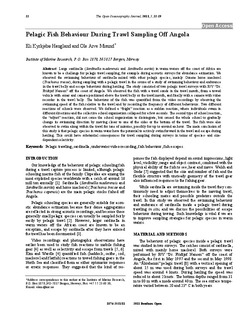Pelagic Fish Behaviour During Trawl Sampling Off Angola
Journal article, Peer reviewed
Permanent lenke
http://hdl.handle.net/11250/109288Utgivelsesdato
2011-12-16Metadata
Vis full innførselSamlinger
- Articles [3011]
Originalversjon
10.2174/1874252101105010022Sammendrag
Large sardinella (Sardinella maderensis and Sardinella aurita) in warm waters off the coast of Africa are
known to be a challenge for pelagic trawl sampling, for example during acoustic surveys for abundance estimation. We
observed the swimming behaviour of sardinella mixed with other pelagic species, mainly Cunene horse mackerel
(Trachurus trecae), during sampling with a pelagic trawl in the course of a study of swimming behaviour and endurance
in the trawl belly and escape behaviour during hauling. The study consisted of two pelagic trawl surveys with R/V “Dr.
Fridtjof Nansen” off the coast of Angola. We observed the fish with a trawl sonde in the trawl mouth, from a towed
vehicle with sonar and camera positioned above the trawl belly or the trawl mouth, and finally with a camera with video
recorder in the trawl belly. The behaviour of the fish was quantified from the video recordings by observing the
swimming speed of the fish relative to the trawl and by recording the frequency of different behaviours. Two different
reactions of schools were observed. We defined a “fright” reaction as a sudden reaction, where individuals swam in
different directions and the collective school organisation collapsed for a few seconds. The second type of school reaction,
the “adjust” reaction, did not cause the school organisation to disintegrate, but caused the whole school to gradually
change its swimming direction by moving closer to one of the sides or the bottom of the trawl. The fish were also
observed to swim along within the trawl for tens of minutes, possibly for up to around an hour. The main conclusion of
this study is that pelagic species in warm water have the potential to actively swim forward in the trawl and escape during
hauling. This could have substantial consequences for trawl sampling during surveys in terms of species- and sizedependent
selectivity.
